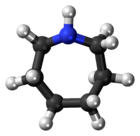This is the current revision of this page, as edited by Marbletan (talk | contribs) at 13:32, 26 September 2024 (unnecessary and unwieldy - a curated handful of examples is sufficient). The present address (URL) is a permanent link to this version.
Revision as of 13:32, 26 September 2024 by Marbletan (talk | contribs) (unnecessary and unwieldy - a curated handful of examples is sufficient)(diff) ← Previous revision | Latest revision (diff) | Newer revision → (diff)
| |||
| Names | |||
|---|---|---|---|
| Preferred IUPAC name Azepane | |||
Other names
| |||
| Identifiers | |||
| CAS Number | |||
| 3D model (JSmol) | |||
| ChEBI | |||
| ChEMBL | |||
| ChemSpider | |||
| ECHA InfoCard | 100.003.524 | ||
| PubChem CID | |||
| UNII | |||
| CompTox Dashboard (EPA) | |||
InChI
| |||
SMILES
| |||
| Properties | |||
| Chemical formula | C6H13N | ||
| Molar mass | 99.177 g·mol | ||
| Appearance | colorless liquid | ||
| Density | 0.88 g/cm | ||
| Melting point | −37 °C (−35 °F; 236 K) | ||
| Boiling point | 138 °C (280 °F; 411 K) (749 mmHg) | ||
| Hazards | |||
| Flash point | 30 °C (86 °F; 303 K) | ||
| Except where otherwise noted, data are given for materials in their standard state (at 25 °C , 100 kPa).
| |||
Azepane is the organic compound with the formula (CH2)6NH. It is a colorless liquid. A cyclic secondary amine, it is a precursor to several drugs and pesticides. It is produced by partial hydrogenolysis of hexamethylene diamine.
Like many amines, it reacts with carbon dioxide.
Azepane-containing drugs
A variety of pharmaceutical drugs contain an azepane ring including bazedoxifene, cetiedil, glisoxepide, mecillinam, nabazenil, setastine, and tolazamide, among others.
See also
References
- ^ "Hexamethyleneimine".
- Karsten Eller; Erhard Henkes; Roland Rossbacher; Hartmut Höke (2005). "Amines, Aliphatic". Ullmann's Encyclopedia of Industrial Chemistry. Weinheim: Wiley-VCH. doi:10.1002/14356007.a02_001. ISBN 3527306730.
- Sanz-Pérez, E. S.; Arencibia, A.; Sanz, R.; Calleja, G. (2016). "New developments on carbon dioxide capture using amine-impregnated silicas". Adsorption. 22 (4): 366–375. doi:10.1007/s10450-015-9740-2. S2CID 100692983.

